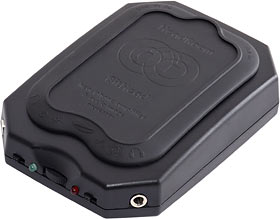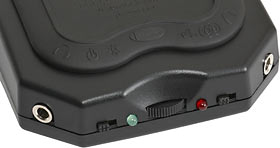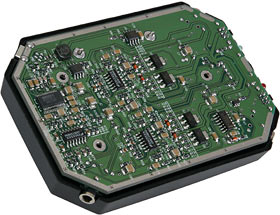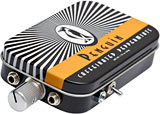
HeadRoom BitHead headphone amplifier
Review date: 18 May 2004.Last modified 03-Dec-2011.
As I explained in the review of this little item, a headphone amplifier can do a lot more than just make headphones louder.
Many portable devices, and a shameful number of mains-powered audio components (most definitely including PCs) are not good at driving headphones at even moderate volume. It's not hard to make a decent headphone amplifier and include it in such products, but decent headphone amps use battery power, and their effect isn't noticed by many customers, so practically every device that isn't specifically made to output sound through headphones, and most devices that are, sound better through headphones if you add an outboard amp.
There are some exotic multi-channel surround-sound headphone amps out there, and other ones optimised to drive unusual kinds of headphones, but the usual plain stereo kind are all, conceptually, much the same. They're a high fidelity, low power analogue amplifier. There are many circuits, but they all aim to do much the same job.
And then, there's this.
HeadRoom's BitHead is the second cheapest headphone amplifier they make, but it still doesn't sell for pocket change; it's $US199.
If you own a computer and a portable player and want better headphone sound for both, though, the BitHead's a bargain. It's two headphone amps in one. Maybe even three, depending on how you count.
On one end of the BitHead, there's a pair of 1/8th inch stereo headphone outputs.
(And a volume wheel, and a power switch and LED, and another switch and light that I'll get to in a moment.)
The twin outputs aren't necessarily very useful for computer applications, but they're great for portable use, as long as two nearby people can agree on what they want to listen to.
This is a proper double-headed amp, not just a dumb two-sockets-in-parallel setup. Plugging in a second set of headphones doesn't make the first set quieter.
So the BitHead's almost two amps in one, right there.
On the other end of the thing, there's another 1/8th inch stereo socket, for input. And a mini-USB connector.
The BitHead, you see, is an analogue headphone amp, and a USB audio device. Plug it into any vaguely recent Windows PC or Mac (and, probably, recent Linux machines as well, though I'm making no promises) and the built in USB audio device drivers will swiftly set it up as another audio adapter. A very clean, nice sounding audio adapter.
And, for Windows users at least, an audio adapter that can be set up not to play thBEEPe systYOU'VE GOT MAIL!em sounds which might otheBONGrwise interrupQUACKt you enjoyment oFARTFARTFARTf your musiDINGc. I talk about how to do this in an old USB audio widget review here; directing system sounds to one audio adapter and music to another is much the same in WinXP as it is in Win2000.
For mobile use, you need batteries, and the BitHead runs from four AAAs, in a battery bay with a very robust push-fit rubber cover. AAAs are a decent choice for an amp of this size - 10.5 by 7.5 by 2.5cm (4.125 by 2.875 by one inch). The BitHead weighs about 165 grams (5.8 ounces) with its batteries loaded, without any cables.
Four alkaline AAA batteries with nominal six volt output between them will give a total energy content in the vicinity of 6.6 watt-hours, because AAAs have a capacity of about 1100 milliamp-hours (mAh). A nine volt alkaline has higher terminal potential but, probably, a capacity of only about 550mAh (and it only manages that at a lower drain level than AAAs can handle), so it'll manage only around five watt-hours of capacity.
This matters, for mobile headphone amp applications. A headphone amp is one more thing whose batteries can go flat, so you want lengthy run time. HeadRoom quote run times of about 30 hours for the BitHead (you may get quite a bit more if you run efficient headphones at modest volume; you probably won't get much less), which matches longer-lived portable players quite well.
To use the BitHead in USB mode, you don't have to turn the power switch on; it'll run perfectly happily from the five volt USB power supply. But you can flick the switch, if you've installed some batteries. From battery power, the BitHead's power light glows brighter, and its clipping level becomes considerably higher - you can wind the volume up further, probably all the way to maximum, without hearing the harshness of an overdriven amplifier.
(The second LED on the controls end of the BitHead is a clipping indicator, by the way. It's more useful than you'd think, even if you're riding a bus and can't really hear mild distortion, because if it starts glowing at medium volume levels, that means the batteries are going flat.)
The BitHead's stronger performance from battery power makes sense. From USB, the BitHead's running from five volts. From four AA alkalines in decent condition, it's getting six volts. More, actually, for really new alkalines; even if they've been on the shelf for a few months, four new alkalines should manage around 6.4 volts between them. And they won't sag much under load in a BitHead, because the BitHead isn't much of a load; that 30 hour run time indicates a current draw in the neighbourhood of 40 milliamps, which isn't too terrifying for a modern AAA.
This also explains why HeadRoom don't recommend you use rechargeable AAAs with the BitHead. They'll work, and modern high-cap NiMH AAAs should last quite well too (as long as you don't expect them to be able to stay charged if the amp's sitting on the shelf for weeks), but with only 4.8 nominal volts, the amp circuit will be gasping at quite modest volume levels.
The full BitHead kit includes USB and 1/8th inch analogue leads of surpassing shortness. This is just what you want for laptop and portable player use, but you'll very probably need extension cables for use with a PC, stereo system or what have you.
There's also a selection of self-adhesive feet to stick on the amp. Three plain rubber ones, but also four sets of three Velcro feet, in white, black and two shades of grey. Thus can you colour-match your BitHead attachment points to your mobile player, but the extra Velcro feet also let you set up multiple "docking points" for the BitHead (MP3 player, laptop, two different desks...) without buying any more Velcro.
HeadRoom provide a handy How To Mount Your BitHead (or AirHead) guide in PDF format, here. It's duplicated in the manual (downloadable here).
Inside
I wasn't quite motivated enough to unsolder the BitHead's battery contacts, which is what you have to do if you want to lift the circuit board right out of the casing...
...but removing the three case screws to reveal this side of the board wasn't a big deal.
The USB audio chip is a Burr-Brown (now owned by Texas Instruments) PCM2902E stereo audio codec with USB interface, supporting sample rates up to 48kHz and all the rest of the usual USB audio device features.
This isn't just trivia, if you're running Linux or some other non-Windows, non-Mac-OS operating system; if you've got a driver for a PCM2902, the BitHead should work with it. Linux looks pretty safe.
Listening
As regular readers know, I am not a fan of obscure terms for sonic qualities. "Air", "musicality", "articulation" and "silkiness" are not even as sharply defined as the odd flavour names used by wine tasters. This jargon isn't actually connectable with any other identifiable thing in the world, and most if not all of the people who use it are, if you ask me, fooling themselves.
If you must, though - the BitHead's treble is pleasantly herbaceous, its midrange is filled with chocolatey goodness, and its bass is phat.
Snake oil aside, the BitHead has some quite clear advantages.
First of all, it's got a crossfeed processor. That's what the second switch on the end of the amp is for.
HeadRoom refer to this feature as an "Audio Image Processor". In these days of digital HRTF processing and 3D positional audio, you might expect something with a name like this to be doing DSPed stereo expansion, or something. I've reviewed devices that do just this in the past.
Actually, though, this is just crossfeed. All it basically does is feed a little of the right channel signal to the left channel, and a little of the left channel to the right. That, you can do with passive components; the BitHead's crossfeed processor is more advanced, and frequency-filters and marginally delays the crossfed signals. This simulate the version of the right-ear signal that the left ear hears in the normal, non-headphoned world, and vice versa.
The idea of all this is to make headphones sound like loudspeakers.
Normally, headphones almost completely isolate the right and left channels from each other; each ear gets to hear practically none of the signal that goes to the other ear.
Most music, however, is mixed to be listened to on speakers. The people producing the recording assumed that there'd be crosstalk between the channels. Crossfeed puts that crosstalk back, and it makes a lot of music sound better. Instead of the classic "orchestra inside your head" headphone sound, it gives you a narrower soundstage that seems to be a bit further forward, which is often a distinct improvement in realism. Not to mention comfort.
Many "very stereo" recordings, with channels that're quite different from each other, can be quite fatiguing to listen to through plain headphones. The extreme example is those old early-stereo rock and roll recordings where each instrument is panned pretty much 100% to one side or the other, but there are plenty of other recordings that're just easier to listen to with crossfeed, never mind stereo realism.
Some material definitely sounds better without crossfeed, though. Mono recordings, of course, and binaural recordings (made with a head-simulating stereo microphone, and intended for playback through headphones) and positional audio in games, for instance. Also various twiddled electronica and other heavily processed music which may or may not have very dissimilar channels, but which also has wiggy phase differences between those channels that means crossfeed - or just mixing the channels into mono - will eat a lot of the sound via straight cancellation.
No problem, though; when the BitHead's crossfeed sucks, you can just turn it off.
My attitude to the sound quality of my current motherboard's integrated audio adapter has, for the last year, been "eh, it'll do". By itself it wasn't much of a headphone driver, but juiced up with an outboard amp, it passed muster.
The BitHead, in regular analogue headphone amp mode, doesn't do anything for the computer's sound quality that the CMoy doesn't. It also doesn't, to my ears at least, sound different from the CMoy when used with a portable player.
This is fair enough; the CMoy circuit may lack the BitHead's extra features (crossfeed, dual outputs, clipping indicator), but nobody debates the thing's quality in the $US100-ish basic-headphone-amp market. The difference between un-amplified headphone audio from various devices and CMoy-amplified audio is likely to be much, much bigger than the difference between CMoy-amplified quality and $US5000 ultra-amp quality, unless you insist on using some bizarre headphones that need the muscle of a full sized power amp to drive them.
The BitHead in USB mode, however, is a clear step up from integrated motherboard audio output - and, I'd confidently say, from the output quality of a bunch of add-on sound cards, too.
There are plenty of truly professional quality PC audio adapters on the market now, which may not have the full feature set a real pro needs to get work done (lots of input and output channels for mixing, for instance), but which absolutely do qualify in the noise, crosstalk, frequency response and internal processing bit depth departments.
Consumer sound cards, however, are generally either pretty rough and ready (but cheap), or full of bells and whistles but, often, sadly lacking in the basic audio qualities demanded by sensible (as opposed to unbalanced) audiophiles.
This is because truly high fidelity, particularly in the analogue portion of the signal path, costs money. I'm not talking voodoo, here, just things like good output amp chips, and good isolation of the analogue signal paths from the radio frequency noise storm that is the inside of a computer case. Like good headphone amplification in portable music devices, really hi-fi output from computer audio adapters will go completely un-noticed by most users. Including me, most of the time; when I'm playing a game full of screams and explosions, I don't give a toss whether my audio adapter has a dynamic range of 30 or 300 decibels.
Wind the USB-connected BitHead all the way up, though, and you don't hear the thrum of computer background activity, at least partly because the whole audio adapter is outside the computer case, not just the final amplifier. The BitHead itself is, for practical intents and purposes, silent.
(If you plug in an analogue input cable while the BitHead's connected to a computer via USB, by the way, the BitHead will mute the USB audio. It doesn't disable the USB audio adapter completely - the computer still thinks it's connected, and will keep playing perfectly happily - but you'll only hear the analogue input signal until you unplug the analogue cable again.)
The effect of a quality headphone amp is, as I've noted before, not obvious in all program material. Something without a great deal of sonic detail and subtlety in the first place can only be made louder by an amp. Which is good by itself, of course, but not really worth big bucks.
Trundling through the usual audiophile suspects, though (plus some weirdness, and some jazz Bach that logically ought to suck yet doesn't) convinced me of the BitHead's quality.
The BitHead's low noise level also helped me gain a new appreciation for the awfulness of a few dubiously encoded MP3s. Every little underwater ululation, every fsshed-out cymbal, every stereo flutter, came through loud and clear, no matter how quiet the passage it was polluting.
As did the distortion crunch of overloaded mics on dodgily engineered live recordings, Oscar Bleeding Peterson and Glenn Bloody Gould warbling away tunelessly in the background of their music, and various other things I'd rather not hear.
You can't blame the BitHead for this, though.
I await a headphone amp with a "Decrapulate" knob with bated breath.
Overall
HeadRoom describe themselves as "obsessed headphone geeks", and that's how their site reads. They're out to convert people to the One True Faith of Strap-On Audio Transducers, sure enough, but they're not out to do it by buzzwording their customers to death, and they're not trying to hard-sell you either. If you doubt me, just check out their range of headphones; they're not afraid to describe some of them very unflatteringly indeed.
HeadRoom will be very happy to sell you the parts-upgrade Total BitHead for a bit more money (they'll also give you credit for the purchase price of a BitHead in the first 30 days, if you'd like to upgrade to the Total variant), but they're not precious about it. I check out the Total BitHead here.
If you've got the money and the inclination, of course, HeadRoom will be happy to sell you something more impressive from their selection of headphone amplifiers, most of them their own designs. You can spend thousands of dollars on one if you want. But even though HeadRoom regard the BitHead as being only "upper-mid-fi", its sound quality is already considerably beyond what most people would call hi-fi. It's certainly good enough for me.
The only HeadRoom amp cheaper than the BitHead, by the way, is the AirHead - which is a BitHead without the USB.
The HeadRoom marketing department's just a tad too twee if you ask me; the cover sheet that came with my review BitHead opened with "Hi! Holy mackerel, we're excited to introduce you to our latest product...". It concluded with some nice solid specification graphs, though (frequency response almost dead flat from ultrasonic to 120Hz, and only 1dB down at 20Hz!), so I can forgive them.
I also think HeadRoom edge over into audiophile nuttitude from time to time; they talk, for instance, about new headphones requiring "break in" time, which is plausible since they contain moving transducers which can indeed loosen up over the first several hours of operation. But HeadRoom also say that amplifiers, including the BitHead, require breaking in. The belief that solid state components (including cables...) should be broken in is common among audiophiles, but as far as I know it remains unencumbered by proof of any kind.
(No, you don't have to be able to measure it; if it can be heard, it can be detected in a blind test, despite strange pseudo-postmodernist arguments about how testing such claims misses the point.)
Forget all this carping, though. The BitHead is an excellent product, which fills a niche nobody else seems to have discovered. It's well engineered physically and electronically, it does the work of two other gadgets, it's well documented, and it's not stupidly expensive when you consider what you're getting.
As I write this, I've got a big ol' box full of headphones waiting to be reviewed. I look forward to plugging them all into the BitHead. Possibly two at a time.
Highly recommended.
Review BitHead kindly provided by HeadRoom.









![[SecureWebs]](images/sw.gif)